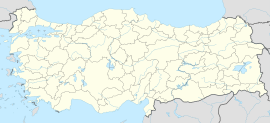Eskihisar, Nusaybin
Eskihisar | |
|---|---|
| Coordinates: 37°09′54″N 41°23′17″E / 37.165°N 41.388°E | |
| Country | Turkey |
| Province | Mardin |
| District | Nusaybin |
| Population (2021)[1] | 162 |
| Time zone | UTC+3 (TRT) |
Eskihisar (Kurdish: Marinê; Syriac: Maʿarrīn)[2][nb 1] is a neighbourhood in the municipality and district of Nusaybin, Mardin Province in Turkey.[4] The village is populated by Kurds of the Çomeran tribe and had a population of 162 in 2021.[1][5] It is located atop Mount Izla in the historic region of Tur Abdin.[6]
History
[edit]Maʿarrīn (today called Eskihisar) was historically inhabited by Christians belonging to the Church of the East.[7] In 1271, 70 villagers from Maʿarrīn helped reconstruct the church of the nearby Monastery of Mar Awgin alongside its monks and those of the Mar Yohannan Monastery on the initiative of ʿAbdīshōʿ Bar Mshak of Gaṣlōnā, metropolitan bishop of Nisibis, according to a historical note by the sixteenth-century monk Abraham of Kirkuk.[8] The restoration took place under the supervision of the architect Raḥmūn.[9] In the first half of the fourteenth century, the village gained a community of Syriac Orthodox Christians who were served by the bishop of Ma'arre, Nisibis, and Gazarta of Qardu.[7]
In 1403 (AG 1714), Maʿarrīn was destroyed alongside Nisibis, the nearby villages of Hbab (today called Güzelsu) and Arbo, and the Monastery of Mar Shim’un at Arbo during an attack on the Beth Risha region by the lords of Hisn Kifa.[10] Philoxenus Ibrahim of Manim’am, Syriac Orthodox metropolitan bishop of the diocese of Arbo, Nisibis, M’arē, and Kartwoytō, also known as the diocese of Beth Risha, is attested in 1454 (AG 1765).[11] He had been ordained by Ignatius Qoma, patriarch of Tur Abdin, and was transferred to the diocese of Amid in 1455.[12]
The diocese of Maʿarrīn is mentioned in 1562 in a letter from the patriarch Abdisho IV Maron to Pope Pius IV amongst those that recognised his authority.[13] It has been suggested that the Church of the Beni Shmūni at Maʿarrīn, which had originally belonged to the Church of the East, was taken over by the Syriac Orthodox Church at some point in the seventeenth or eighteenth centuries, probably as a result of the villagers' conversion amidst the schism between traditionalists and Catholics in the Church of the East.[14] All of the Christians at Maʿarrīn adhered to the Syriac Orthodox Church by 1766.[15]
The Syriac Catholic bishop Gabriel Tappouni recorded that 80 Assyrians in 15 families lived at Maʿarrīn in 1913 and were served by one priest.[16] In 1914, the village was inhabited by 400 Assyrians, as per the list presented to the Paris Peace Conference by the Assyro-Chaldean delegation.[17] There were 50 Assyrian families in 1915.[18] It was located in the kaza (district) of Habab, attached to the kaza of Nisibis.[17] The village served as the residence of the chief of the Kurdish tribe of Hajo of the Haverkan confederation.[19] By 1987, there were no remaining Assyrians.[18]
References
[edit]Notes
Citations
- ^ a b "31 ARALIK 2021 TARİHLİ ADRESE DAYALI NÜFUS KAYIT SİSTEMİ (ADNKS) SONUÇLARI" (XLS). TÜİK (in Turkish). Retrieved 16 December 2022.
- ^ Wilmshurst (2000), p. 44.
- ^ Courtois (2004), p. 225; Wilmshurst (2000), p. 44; Gaunt (2006), p. 187; Al-Jeloo (2015), p. 114; Courtois (2004), p. 42; Barsoum (2008), pp. 16, 76; Bcheiry (2013), p. 24; Jongerden & Verheij (2012), p. 325.
- ^ Mahalle, Turkey Civil Administration Departments Inventory. Retrieved 19 September 2023.
- ^ Tan (2018), p. 139.
- ^ Barsoum (2008), p. 16; Bcheiry (2013), p. 24.
- ^ a b Wilmshurst (2000), p. 47.
- ^ Wilmshurst (2000), pp. 46, 47–48.
- ^ Wilmshurst (2000), p. 46.
- ^ Barsoum (2008), p. 76.
- ^ Bcheiry (2013), p. 48; Barsoum (2008), p. 47.
- ^ Barsoum (2008), pp. 29, 47.
- ^ Wilmshurst (2000), p. 349.
- ^ Al-Jeloo (2015), p. 114; Wilmshurst (2000), pp. 47–48.
- ^ Wilmshurst (2000), p. 48.
- ^ Courtois (2004), p. 42.
- ^ a b Gaunt (2006), p. 425.
- ^ a b Courtois (2004), p. 225.
- ^ Gaunt (2006), p. 187.
Bibliography
[edit]- Al-Jeloo, Nicholas (2015). "Transferrable Religious Heritage: Church Buildings in Northern Mesopotamia". Le patrimoine architectural de l’Église orthodoxe d’Antioche: Perspectives comparatives avec les autres groupes religieux du Moyen-Orient et des régions limitrophes. Publications of the University of Balamand. pp. 111–127. Retrieved 14 October 2024.
- Barsoum, Aphrem (2008). The History of Tur Abdin. Translated by Matti Moosa. Gorgias Press. Retrieved 1 April 2021.
- Bcheiry, Iskandar (2013). The Account of the Syriac Orthodox Patriarch Yūḥanun Bar Šay Allāh (1483–1492): The Syriac Manuscript of Cambridge: DD.3.8(1). Gorgias Press.
- Courtois, Sébastien de (2004). The Forgotten Genocide: Eastern Christians, The Last Arameans. Translated by Vincent Aurora. Gorgias Press.
- Gaunt, David (2006). Massacres, Resistance, Protectors: Muslim-Christian Relations in Eastern Anatolia during World War I. Gorgias Press. Retrieved 21 May 2023.
- Jongerden, Joost; Verheij, Jelle (2012). Social Relations in Ottoman Diyarbekir, 1870-1915. Brill.
- Tan, Altan (2018). Turabidin'den Berriye'ye. Aşiretler - Dinler - Diller - Kültürler (in Turkish). Pak Ajans Yayincilik Turizm Ve Diş Ticaret Limited şirketi. ISBN 9789944360944.
- Wilmshurst, David (2000). The Ecclesiastical Organisation of the Church of the East, 1318–1913. Peeters Publishers.

